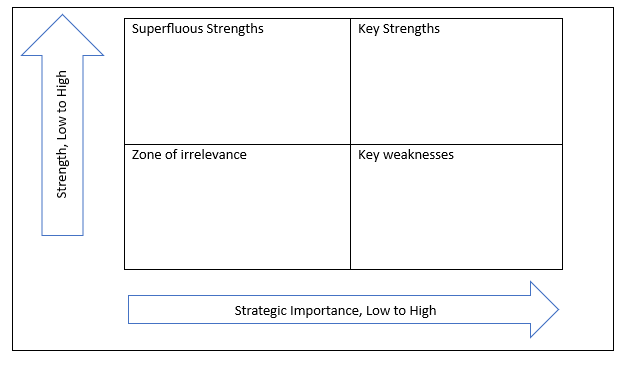Introduction to Leaders using internal analysis when developing strategy
There is a wealth of information on strategy available for leaders. This reflects on how important strategic approaches and strategy are for getting ahead and staying ahead in business and when leading teams. Taking a strategic approach enables leaders to focus on what they are setting out to achieve, provides leaders with a better understanding of the current situation, and sets direction for leaders, their team, and their organisation.
In this blog we will explore internal strategic analysis covering what it is, why it is important and how to do it. This will provide you with specific knowledge in a way that you can then implement to develop your strategic leadership skills.
Bite Size ‘Simple Steps’ (TLDR) – 4 Steps to Implementing Internal Strategic Analysis
- Clarify Purpose and Goals
- Explanation: Clearly define the purpose and goals of your organisation or team. This foundational step ensures that all subsequent analysis is aligned with what you aim to achieve.
- Example: A software development company aims to become the market leader in AI-driven solutions within three years. The leadership team sets specific goals, such as increasing market share by 15% annually and launching two innovative AI products per year.
- Identify and Evaluate Internal Resources
- Explanation: Conduct a detailed assessment of your tangible, intangible, and human resources. Evaluate each resource’s strength and strategic importance using a structured approach.
- Example: The company evaluates its resources:
- Tangible: Finances (rated 8/10), Office space and equipment (rated 7/10)
- Intangible: Proprietary technology (rated 9/10), Brand reputation (rated 7/10)
- Human: Technical skills of staff (rated 8/10), Leadership capability (rated 6/10)
- Analyse and Categorise Resources
- Explanation: Rate each resource for its strength and strategic importance. Categorise the resources into key strengths, key weaknesses, superfluous strengths, and zone of irrelevance.
- Example: The company categorises its resources:
- Key Strengths: Proprietary technology (9/10 strength, 10/10 importance), Technical skills of staff (8/10 strength, 9/10 importance)
- Key Weaknesses: Leadership capability (6/10 strength, 9/10 importance)
- Superfluous Strengths: Office space and equipment (7/10 strength, 3/10 importance)
- Zone of Irrelevance: None identified
- Develop Strategic Actions
- Explanation: Based on the analysis, decide on actions to leverage key strengths, address key weaknesses, optimize superfluous strengths, and ignore or minimise focus on areas in the zone of irrelevance.
- Example:
- Leverage Key Strengths: Invest further in proprietary technology and technical skills through advanced training and R&D.
- Address Key Weaknesses: Enhance leadership capability by implementing leadership development programs and hiring experienced leaders.
- Optimize Superfluous Strengths: Consider downsizing office space to reduce costs and reinvest savings in more critical areas.
- Ignore Zone of Irrelevance: No actions needed as no irrelevant resources were identified.
What is Strategy?
Strategy is a process following three key phases:
- Strategic analysis
- Strategic decision making
- Developing a strategic plan and putting it into action.
Leaders use internal strategic analysis in the first phase. The initial step within strategic analysis is for leaders to establish their and their team’s purpose and aims. Analysis of the external environment, internal resources and stakeholders are then completed referring back to the purpose.
If you are a leader who wants to develop, learn more about the strategic tools to use and understand how these interact to develop a strategy, read, and use Strategy in Simple Steps. This book will guide you through all phases of developing a strategy, and includes the necessary tools to turn new knowledge into skills you use in practice. You will be transformed as a leader and transform your teams and organisation.
What is internal analysis and how do leaders complete one?
Strategic internal analysis is simply about understanding your strengths and weaknesses in relation to your purpose, whether as an individual, a leader, a team or as an organisation. You can just list your strengths and weaknesses but ask yourself whether this provides you with the depth of analysis you require or just provides you with a list?
If you really want to lead and optimise what you are setting out to achieve, there are some simple steps to follow to complete an analysis. Following a more systematic approach with headings to help consider the multiple aspects of the internal environment provides a structure which helps leaders when they come to the next phase of deciding what to do and what not to do. Leaders following this process will impress and engage their team and their boss.
To complete an internal analysis leaders can consider resources as ‘tangible’ or real; ‘intangible’ with no physical presence; and ‘human’ – qualities and behaviours of individuals, the team and organisation.
For each aspect, leaders can consider the resources available. For example, finances could include income or loans; Physical resources could be buildings, computers, desks, and chairs. These can be listed in the table below under the heading ‘Description’.
| Resources | Description | Strength of the Resource (Rated /10) | Strategic Importance of the Resource (Rated /10) | |
| Tangible | Finances available | |||
| Physical resources | ||||
| Intangible | Technology | |||
| Reputation | ||||
| Brand | ||||
| Culture | ||||
| Human | Skills and knowledge | |||
| Capacity | ||||
| Motivation |
So far you will have developed an organised list. So how do strategic leaders progress this to an analysis which can inform what they do and don’t do?
As can be seen in the table above, there are columns for ‘strength of the resource’ and ‘strategic importance of the resource’. In the ‘strength of the resource’ column, rate the resource out of 10, where 1 is extremely weak, and 10 is extremely strong. Next, in the ‘strategic importance of the resource’ column, do the same but this time rating the strategic importance of the resource out of 10.
Leaders who complete this approach will identify areas of strength. They may also find they have a number of weaknesses in areas which are important to them, their team and organisation. They may also find they have strengths that aren’t currently of benefit to them, their team, or their organisation. The findings can be categorised under four headings of key strengths, key weaknesses, superfluous strength, and zone of irrelevance as follows:
- Key Strength: Strength rated 6 – 10; Strategic importance rated 6 – 10
- Key Weakness: Strength rated 1 – 5; Strategic importance rated 6 – 10
- Superfluous Strength: Strength rated 6 – 10; Strategic importance rated 1 – 5
- Zone of Irrelevance: Strength rated 1 – 5; Strategic importance rated 1 – 5
For a more visual aid, leaders can use the table below, placing each resource listed in the appropriate box.

Key strengths may be maintained or developed further, and clearly recognised as aspects which are important to achieving your goals. Aspects in key weaknesses will need to be developed as they are not relevant to your purpose. Resources in the zone of irrelevance are not required and do not need any focus or development as it they are neither a strength or relevant to your purpose.
A decision will need to be made on any superfluous strengths. This can be a good time to pause and reflect on purpose and aims. If there a number of superfluous strengths, changing your purpose and goals may move the superfluous strengths to key strengths.
This approach enables leaders to clearly identify areas to ignore, focus on, develop, or seek ways to use a known strength. For example, an organisation may deal in taxi rides but recruited staff with knowledge, skills, and experience with gyms. This could be an opportunity to diversify the business, or seek some way to combine the two, such as partnerships with gyms, such as taxi rides to get there.
Using internal analysis alongside developing purpose, external analysis and stakeholder analysis is a skill leaders should develop. It enables leaders to lead strategically and develop strategy for their teams and organisation.
Summary
Let’s re-cap. Leaders take a strategic approach to improve themselves, their teams, and their organisation. Strategy is a process following three key phases of (i) strategic analysis; (ii) strategic decision making; and (iii) developing a strategic plan and putting it into action. The first step of strategic analysis is to clarify purpose and goals. This is followed by analysis of the external environment, internal resources, and key stakeholders in relation to the purpose. Leaders using tools for analysis of internal resources take a systematic approach to make informed decisions. This is also a great way to involve and engage with your teams.
To learn more about strategy, read Strategy in Simple Steps.The book provides an introduction to strategy. It takes you through the tools to use to develop strategy in an easy-to-follow practical approach. The book will become your go to reference guide as a leader.





